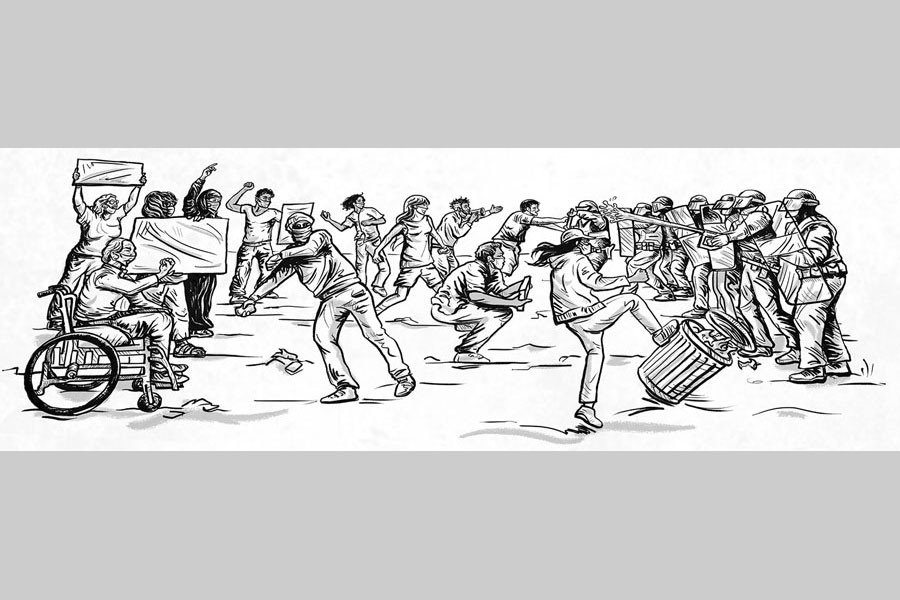In 1832, the great cholera pandemic hit Paris. In just a few months, the disease killed 20,000 of the city's 650,000 population. Most fatalities occurred in the heart of the city, where many poor workers lived in squalid conditions, drawn to Paris by the Industrial Revolution.
The spread of the disease heightened class tensions, as the rich blamed the poor for spreading the disease and the poor thought they were being poisoned. Animosity and anger were soon directed at the unpopular King. The funeral of General Lamarque-pandemic victim and defender of a popular causes-spurred large anti-government demonstration on the barricaded streets: scenes immortalised in Victor Hugo's novel Les Misérables.
Historians have argued that the epidemic's interaction with pre-existing tensions was a principal cause of what came to be known as the Paris Uprising of 1832, which may, in turn, explain subsequent government repression and public revolt in the French capital in the 19th century.
From the Plague of Justinian and the Black Death to the 1918 Influenza Epidemic, history is replete with examples of disease outbreaks casting long shadows of social repercussions: shaping politics, subverting the social order, and some ultimately causing social unrest. Why? One possible reason is that an epidemic can reveal or aggravate pre-existing fault lines in society, such as inadequate social safety nets, lack of trust in institutions, or perception of government indifference, incompetence, or corruption. Historically, outbreaks of contagious diseases have also led to ethnic or religious backlashes or worsened tensions among economic classes.
Despite ample examples, quantitative evidence on the link between epidemics and social unrest is scant and limited to specific episodes. Recent IMF staff research fills this gap by offering global evidence of this link in recent decades.
A key challenge for research on social unrest is identifying when events of unrest have occurred. Although sources of information on unrest are available, many are at low frequency or have inconsistent coverage. To address these shortcomings, a recent IMF staff paper uses an index based on press coverage of social unrest to create a Reported Social Unrest Index. This provides a consistent, monthly measure of social unrest for 130 countries from 1985 to the present.
Spikes in the index line up very closely with narrative descriptions of unrest in a variety of case studies, suggesting that the index captures real events rather than shifts in media sentiment or attention.
Using this index, the IMF staff study finds that countries with more frequent and severe epidemics also experienced greater unrest on average.
During and immediately after a pandemic, the social scarring in the form of unrest may not show up quickly. Indeed, humanitarian crises likely impede the communication and transportation needed to organise major protests. Moreover, public opinion might favour cohesion and solidarity in times of duress. In some cases, incumbent regimes may also take advantage of an emergency to consolidate power and suppress dissent. The Covid-19 experience is consistent with this historical pattern, so far. In fact, the number of major unrest events worldwide has fallen to its lowest level in almost five years. Notable exceptions include the United States and Lebanon, but even in these cases, the largest protests are related to issues that could potentially be exacerbated, but not directly caused by Covid-19.
But looking beyond the immediate aftermath, the risk of social unrest spikes in the longer term. Using the information on the types of unrest, the IMF staff study focuses on the form that unrest typically takes after an epidemic.
This analysis shows that, over time, the risk of riots and anti-government demonstrations rises. Furthermore, the study finds evidence of heightened risk of a major government crisis-an event that threatens to bring down the government and that typically occurs in the two years following a severe epidemic.
If history is a predictor, unrest may re-emerge as the pandemic eases. The threats may be bigger where the crisis exposes or exacerbates pre-existing problems such as a lack of trust in institutions, poor governance, poverty, or inequality.
Philip Barrett is an economist in the IMF's Research Department. Sophia Chen is an economist in the IMF's Research Department. Nan Li is a senior economist in the IMF's African Department and an associate editor of the IMF Economic Review.
This article first appeared in IMF Research Perspectives and republished in IMF Blog
www. blogs.imf.org


